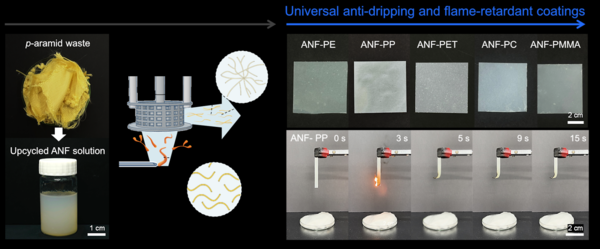Significantly improves fire resistance and self-extinguishing performance of interior automotive plastics

Professor Eom Young-ho of the Department of Organic and Nano Engineering at Hanyang University and his research team have developed a sustainable flame-retardant coating technology that utilizes recycled p-aramid (poly-paraphenylene terephthalamide) fiber waste. The technology, which transforms industrial waste into aramid nanofibers (ANFs), significantly enhances the flame retardancy of various interior plastics used in automobiles. The research is being recognized as a core innovation for both resource recycling and fire safety in next-generation mobility.
Although aramid is a high-performance polymer known for its excellent mechanical, thermal, and chemical stability, its insoluble nature has limited its applicability across various materials. To overcome this, the research team successfully upcycled p-aramid into a stable ANF coating solution that can be dispersed in ethanol.
The developed ANF coating solution adheres uniformly to five major types of plastic substrates commonly found in vehicle interiors—PE, PP, PET, PC, and PMMA—and effectively enhances their flame-retardant properties. In particular, the ANF coating provides each material with anti-dripping and self-extinguishing properties, demonstrating outstanding fire suppression performance.
Performance tests showed an increase in the Limiting Oxygen Index (LOI) across all substrates. In the case of PC (polycarbonate), the LOI rose from 22.4% to 28.8%, surpassing the self-extinguishing threshold. Furthermore, the material exhibited a high char yield of 42.1% during combustion, forming a dense char layer and preventing molten drips, thus significantly reducing fire hazards.

“This study demonstrates how p-aramid waste can be reborn as a high-value-added flame-retardant material,” said Professor Eom. “It marks a meaningful step forward not only in sustainable material utilization but also in enhancing fire safety in future mobility applications.”
The study was supported by the National Research Foundation of Korea and the Korea Institute for Advancement of Technology. The research findings were published in the July 18 issue of ACS Nano (IF 16.0), a prestigious journal in the field of nanoscience. The paper, titled “Upcycling p-Aramid Waste into Universal Antidripping Aramid Nanofiber Coatings for Future Mobility Interior Plastics,” lists HYU master’s student Kim Hyun-jung as the first author, master’s student Kim Hyun-ji as the second author, and Professor Eom Young-ho as the corresponding author.
Click to see the paper:

 '한양위키' 키워드 보기
'한양위키' 키워드 보기